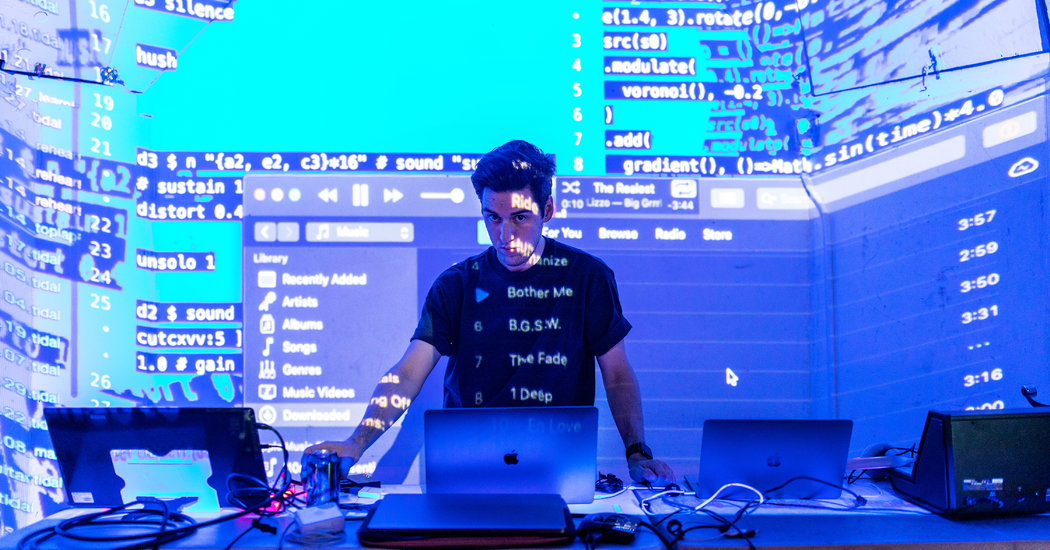
On a computer, Sonic Pi looks like any other coding language. It’s a mess of numbers, parentheticals, punctuation marks and keywords, splattered over an LCD screen. But offscreen — and through a set of quality speakers — those keystrokes produce music you might dance to on a Friday night.
Some artists have eschewed traditional acoustic and electronic instruments to compose with computer code. Colloquially, this is called “live coding” — a D.J. takes the stage with a laptop, opens up a coding interface and constructs melodies in real time. Today, there are live coding shows (sometimes called “algoraves”) almost every weekend in New York City, Moscow, Mexico City and India. Sonic Pi — which can find middle C, summon the Amen Break and play dozens of different synth sounds with just a few commands — has become a favored software among the D.J.s at these live events.
Originally, Sonic Pi was built to be a teaching aid. Sam Aaron, a software designer, was working at the University of Cambridge and wanted to combine the toils of programming with the joy of music. The goal was to invent a coding environment that functioned as an instrument, allowing children to type out rhythm and melody.
“The question was how do we teach kids computer science,” Mr. Aaron said. “Rather than teaching them sourcing algorithms or binary arithmetic,” he had another idea: “Let’s give them some synths and beats.”
Today, Mr. Aaron happily admits that his projection was off. Sonic Pi hasn’t infiltrated classrooms, but it has become a useful tool for experimental composers. That was what drew 29-year-old Melody Loveless, who is classically trained as a percussionist, into the scene. She has been making ethereal, downbeat compositions with code for close to two years now, offloading some of the heavy lifting of rhythm to a set of scripts. That is to say, her arms no longer hold her back. Instead she’s found a new muse in “having my brain sucked into the computer,” she said.
“Something about live coding alleviated a lot of stress. If I’m nervous, the computer can stay on, and I can take my time making a decision,” Ms. Loveless said. With percussion, she said, “I had to be on at every measure, I had to be perfect.”
Jason Levine, 38, a founder of the programming collective Livecode.NYC, reports a similar sensation. He makes music with May Cheung, 31, who improvises vocals over Mr. Levine’s commands.
What drew him to coding was the freedom and flexibility it offered, and the ways it seemed to favor ingenuity over technical musicianship. “You can write, ‘I want this to happen,’ and it happens,” Mr. Levine said. “Compared to traditional instruments, you’re not constrained by your body. It’s your mind going directly into music.” At live shows, those strands of code are also projected at a massive scale for members of the audience to see.
That egalitarianism is a crucial part of the algorave ethos. Sonic Pi, like the vast majority of music-focused coding environments, is free to download and open source. Evan Raskob, a live coder in the United Kingdom who currently works at the University of London, compares it to the punk rock of the ’80s. “The great thing about punk is they played three chords, and you said, ‘I could do that,’” he said. “With live coding, you type in a few lines and hit compile and you’re playing music.”
Mr. Raskob makes music with a 3-D printer. He uses code to instruct the whirs and clunks of the machine to synchronize in a rhythmic way. To him, there is nothing more punk than turning something as flagrantly discordant as a 3-D printer into an instrument. This is the argument of everyone in the community: Coding doesn’t have to be an appendage of the tech industry. It can be as weird as you want it.
“If you imagine a world where we only used writing for legal documents, that’d be a pretty boring world,” Mr. Aaron, the Sonic Pi creator, said. “That’s precisely where we are with code. Most code is used for business purposes. That’s not the end game. In the same way we can read and write poems and lyrics, we need to understand that code can have that expressive quality as well.”







